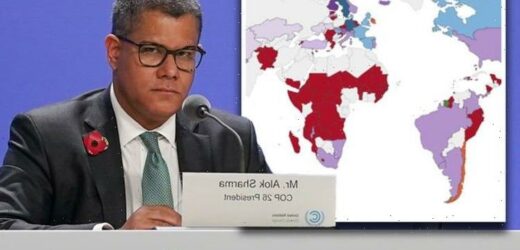Alastair Stewart on who is responsible for fighting climate crisis
We use your sign-up to provide content in ways you’ve consented to and to improve our understanding of you. This may include adverts from us and 3rd parties based on our understanding. You can unsubscribe at any time. More info
World leaders have travelled to Glasgow this week as COP26 begins, a summit seen as crucial to tackling climate change and preventing disaster which would befall the planet if global warming continued. Today COP26 president Alok Sharma warned the summit was the world’s “last, best hope” to limit global warming to 1.5C by 2100.
Speaking at the opening of COP26 today Mr Sharma said: “If we act now, and we act together, we can protect our precious planet.
“So, let’s come together in these two weeks and ensure that where Paris promised, Glasgow delivers.”
Integral to limiting warming to the 1.5C figure by 2100 is reducing carbon dioxide (CO2) emissions.
Extra CO2 in the atmosphere increases the greenhouse effect – warming the planet by trapping thermal energy and causing warmer climates than usual.
Read More: Archaeologists blown away by DNA from mysterious Asian mummies


Some countries have pledged to hit net zero carbon emissions in the future – while others are facing pressure to reach the target sooner.
Figures from our World in Data show the country with the highest CO2 emissions is China, with 10,175 million tonnes in 2019.
And overall China emitted 27 percent of the world’s greenhouse gases in 2019.
Second on the list was the United States, emitting 5,258 million tonnes in 2019, 11 percent of the globe’s greenhouse gases.

CO2 emissions by country – in tonnes, 2019
China – 10,175m – 7.1 per capita
USA – 5,285m – 16.1 per capita
India – 2,616m – 1.9 per capita
Russia – 1,678m – 11.5 per capita
Japan – 1,107m – 8.7 per capita
Iran – 780m – 9.5 per capita
Germany – 702m – 8.4 per capita
Indonesia – 618m – 2.3 per capita
South Korea – 611m – 11.9 per capita
Saudi Arabia – 582m – 17.0 per capita
Source – Our World in Data
China has also been ranked as “highly insufficient” when it comes to climate action, with Russia one level worse at “critically insufficient”.
In 2015, 192 nations signed the Paris Accord which set out a global framework to avoid dangerous climate change.
The UK has promised to hit net zero carbon emissions by 2050, as has the EU, USA and Gambia.
China has pledged to reach net-zero by 2060, as have Russia and India.

Global Climate Promises
UK
Rating: Almost Sufficient
Net Zero target: 2050
Attending COP26: Yes
EU
Rating: Insufficient
Net Zero target: 2050
Attending COP26: Yes
USA
Rating: Insufficient
Net Zero target: 2050
Attending COP26: Yes
China
Rating: Highly insufficient
Net Zero target: 2060
Attending COP26: Via video link
India
Rating: Highly insufficient
Net Zero target: 2060
Attending COP26: YEs
Russian Federation
Rating: Critically insufficient
Net Zero target: 2060
Attending COP26: No
The Gambia
Rating: Sufficient
Net Zero target: 2050
Attending COP26: Unknown
Nigeria
Rating: Almost Sufficient
Net Zero target: 2050 – 2100
Attending COP26: Yes
Nepal
Rating: Almost Sufficient
Net Zero target: 2050
Attending COP26: Unknown
Morocco
Rating: Almost Sufficient
Net Zero target: –
Attending COP26: Unknown
Countries were rated by Climate Action Tracker, which checks national targets against the goal to limit global warming below 1.5C.
The danger of climate change is already apparent, with a report by the World Meteorological Organisation, showing extreme weather events – such as fierce heat waves and deadly floods – are the new normal.
Prime Minister Boris Johnson told the BBC that climate change was “the biggest threat to humanity”, saying it posed a “risk to civilisation basically going backwards”.
With COP26 events to last all week, world leaders will work on future pledges and ways to reduce global pollution.
Source: Read Full Article


